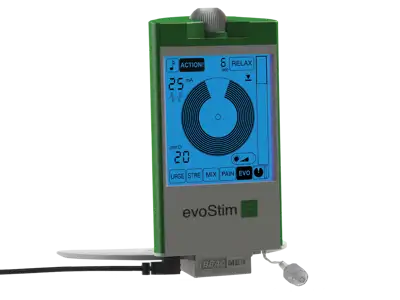Biofeedback devices
The biofeedback device provides biological feedback or indication of body function. It can be used most effectively in rehabilitation treatments, such as re-learning movement.
Read more...The term biofeedback means biological feedback, i.e. feedback on how the body is working. A technique to learn to control certain functions of your body. Biofeedback requires sensors to help you gather information about your body. Based on the feedback you get, you can make subtle changes, such as relaxing certain muscles to reduce pain, for example.
A good example of biofeedback is learning to move in front of a mirror. You control the execution of the movement with your vision and refine the execution of the movement, performing it again and again. Biofeedback gives you the opportunity to learn and practice new ways to control your body.
There are many applications. One of them is for medical use, mainly to promote rehabilitation and recovery after loss of function.
Types of biofeedback
The therapist can choose between different biofeedback methods depending on the health problem and the treatment goal.
Types of biofeedback may include:
- Brainwaves. It monitors the electrical activity of the brain (brain waves) using sensors placed on the scalp. The equipment used is the electroencephalograph (EEG)
- Breath rate. A sensor placed on the abdomen or chest is used to monitor respiratory rate, the rate of breathing.
- Pulse rate. The most common method is a sensor placed on the chest or wrist that measures the electrical activity of the heart (electrocardiograph (ECG) principle). The pulse and the change in pulse rate can be determined. Sensors placed on the finger or earlobe can be used to detect the peripheral pulse and even the change in blood volume of the pulse (the device is called a photoplethysmograph or pulse oximeter)
- Blood contraction. Sensors are placed on the skeletal muscles and the electromyograph (EMG) records the electrical activity associated with muscle contraction.
- Pressure. By placing a pressure sensor in a body cavity (vagina, rectum), the pressure induced during contraction can be recorded.
- Epiratory gland activity.Electrodermograph (EDG) sensors attached around your fingers, palm or wrist measure sweat gland activity and the amount of sweat on your skin, warning of anxiety.
- Temperature. Sensors attached to the fingers or feet measure the blood flow in the skin. Under stress, the flow and body temperature decrease due to the constriction of the skin vessels. Tracking the change may indicate that it is time to start relaxation techniques.
Biofeedback tools
Biofeedback was previously only common in physical therapy, doctors' offices and hospitals. Today, more and more biofeedback devices are being marketed for home use, among other uses.
Pulse rate monitors. Which help you track your heart rate. This is particularly important for people with heart and lung conditions, where the heart rate increases on exertion (which could be working, walking to the shops, etc.). Heart rate monitors can help the patient to find the intensity of activity at which the heart rate increases only moderately and does not cause complaints.
Electromyogram (EMG) based devices. These indicate muscle activity. They play a key role in regenerating the nerve-muscle connection and relearning movement in the case of paralysis caused by stroke. But it is also easier to learn, for example, how to release and release muscle tension caused by stress. The method is becoming increasingly popular in the treatment of urinary and or bowel problems due to weakening of the pelvic floor muscles (incontinence), as the feedback significantly improves the effectiveness of intimate gymnastics. EMG-based devices can also be used in stress management. By monitoring muscle tension and listening to the feedback, you can learn to relax and relax your muscles.
Pressure-based devices can help you regain the ability to hold stool and urine. They can monitor the strength of the muscles that close the vagina or rectum and control the force to recover. It also helps regain control in the event of nerve damage after prostate surgery.
The use ofinteractive computer programs is rapidly expanding in Western rehabilitation practice. Some types of biofeedback devices measure physiological changes in the body, such as the movement of the hand and its direction. The sensors are connected to the computer. Computer graphics help you relax or even tighten muscles, track movement and thus help you relearn how to move.
Another type of biofeedback uses a headband to monitor brain activity. It sends signals to let you know when your mind is calm and when it is active. This helps you learn how to control your stress response.
What can biofeedback be used for?
It can be used to treat a wide range of physical and mental problems
- anxiety or stress (learning stress relief techniques, stress management)
- Asthma (strengthening breathing control)
- Attention Deficit Hyperactivity Disorder (ADHD) (learning to focus)
- Chronic pain
- Sensitivity
- Sensory incontinence (both EMG and pressure biofeedback)
- Fibromyalgia
- Femoral pain
- High blood pressure
- Heart disease - monitoring exercise tolerance
- Irritable bowel syndrome
- Raynaud's disease
- Hear ringing (tinnitus)
- Stroke (EMG-based devices with ETS - to help relearn movement and regain muscle strength)
- Jaw joint disorder
- Movement Difficulty with both EMG and pressure biofeedback)
Biofeedback is useful for people
- Non-invasive (i.e. it collects data from the body surface, so it does not cause discomfort)
- Can reduce or eliminate the need for certain medications
- may increase the effect of medication
- May help those who, for example, cannot take medication during pregnancy.
- It can help you to better control your health.




